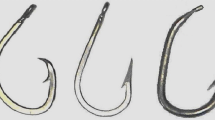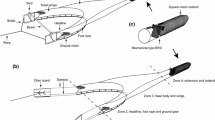Abstract
Our research aims to identify longline fishing gear modifications that can improve fishing selectivity and reduce incidental capture of non-target species. Catch rates and anatomical hook locations (AHL) were compared when using a 14/0 standard “control” circle hook with a 0° offset and an experimental “appendage” hook in a Costa Rican longline fishery. With the appendage, the maximum dimension of the appendage hook was increased by 10% and the minimum dimension of the hook by 19%. A total of 1,811 marine animals were captured during five fishing trips. By taxonomic groups, sea turtles represented the largest total catch (27%), followed by sharks (26%), rays (25%), mahimahi (Coryphaena hippurus) (12%), and tunas and billfish (10%). Non-target and discard species, such as rays and sea turtles, accounted for over half of the total catch. Catch per unit effort (CPUE; number of individuals per 1,000 hooks) was higher with control hooks compared to appendage hooks for all species’ categories except rays; appendage hooks caught 52% fewer sea turtles and 23% fewer tunas and billfish than standard hooks, which represents a significant reduction in bycatch of endangered and other species. No differences were found in the AHL for sea turtles, suggesting use of the appendage may not incur additional advantages regarding turtles’ post-release survivorship. Despite lower catch rates for marketable species, such as sharks and mahimahi, use of the appendage resulted in dramatic reductions in catch rates of sea turtles. The results suggest that large scale adoption of hooks with a significantly wider hook dimension could be an effective conservation measure to maintain marine biodiversity while allowing for continued fishing.






Similar content being viewed by others
References
Alos J, Arlinghaus R, Palmer M, March D, Alvarez I (2009a) The influence of type of natural bait on fish catches and hooking location in a mixed-species marine recreational fishery, with implications for management. Fish Res 97:270–277
Alos J, Mateu-Vicens G, Palmer M, Grau AM, Cabanellas-Reboredo M, Box A (2009b) Performance of circle hooks in mixed species recreational fishery. J Appl Ichthyol 25:565–570
Arauz R, Ballestero J (2003) Evaluación del Dispositivo Excluidor de Tortugas Marinas con espacio de 6 pulgadas entre barras deflectoras conocido como Tico DETen la flota camaronera costarricense. Informe preliminar
Arauz R, Ballestero J, Bolaños A (2004) Species composition, catch rates, and destiny of sea turtles captured during two 6 month observer programs on-board high seas mahimahi (Coryphaena hippurus) longline vessels operating in the Exclusive Economic Zone of Costa Rica. 24th Annual Symposium on Sea Turtle Biology and Conservation, San José, Costa Rica
Barnes PDL, Walshe KAR, Manly BFJ (2004) A comparison of various fish hooks and fish hooks fitted with wire appendages and their effects on reducing the catch of small and gut hooked snapper (Pagrus auratus) by recreational fishers in the Hauraki Gulf of New Zealand. Unpublished data report, 27 pp
Bigelow K, Musyl MK, Poisson F, Kleiber P (2006) Pelagic longline gear depth and shoaling. Fish Res 77:173–183
Bolten A, Bjorndal K (2002) Experiment to evaluate gear modification on rates of sea turtle bycatch in the swordfish longline fishery in the Azores. Final project report submitted to the U.S. National Marine Fisheries Service. Archie Carr Center for Sea Turtle Research, University of Florida, Gainesville, FL
Bolten A, Bjorndal K (2003) Experiment to evaluate gear modification on rates of sea turtle bycatch in the swordfish longline fishery in the Azores—Phase 2. Final project report submitted to the U.S. National Marine Fisheries Service. Archie Carr Center for Sea Turtle Research, University of Florida, Gainesville, FL
Bonfil R (1994) Overview of world elasmobranch fisheries. FAO Fisheries Technical Paper No 341, 119 pp
Camhi MD, Valenti SV, Fordham SV, Fowler SL, Gibson C (2009) The conservation status of pelagic sharks and rays: report of the IUCN shark specialist group pelagic shark red list workshop. IUCN Species Survival Commission Shark Specialist Group. Newbury, UK, 78 pp
Campbell LM, Cornwall ML (2008) Human dimensions of bycatch reduction technology: current assumptions and directions for future research. Endangered Species Research 5:325–334
Campos JA, Segura A, Lizano O, Madrigal E (1993) Basic ecology of Coryphaena hippurus (Pisces: Coryphaenidae) and abundance of other large pelagic in the Pacific of Costa Rica. Rev Biol Trop 41:783–790
Carruthers E, Schneider DC, Neilson JD (2009) Carruthers Estimating the odds of survival and identifying mitigation opportunities for common bycatch in pelagic longline fisheries. Biol Conserv 142:2620–2630
Cooke SJ, Suski CD (2005) Do we need species-specific guidelines for catch-and-release recreational angling to effectively conserve diverse fishery resources? Biodivers Conserv 14:1195–1209
Cornelius SE (1982) Status of sea turtles along the Pacific coast of middle America. In; Bjorndal, K.A., (ed) Biology and Conservation of Sea Turtles. Washington D.C, Smithsonian Institution Press, pp 211–220
Cortés E, Arocha F, Beerkircher L, Carvalho F, Domingo A, Heupel M, Holtzhausen H, Santos MN, Ribera M, Simpfendorfer C (2010) Ecological risk assessment of pelagic sharks caught in Atlantic pelagic longline fisheries. Aquat Living Resour 23:25–34
Dulvy NK, Baum JK, Clarke S, Compagno LJV, Cortés E, Domingo A, Fordham S, Fowler S, Francis MP, Gibson C, Martínez J, Musick JA, Soldo A, Stevens JS, Valenti S (2008) You can swim but you can’t hide: the global status and conservation of oceanic pelagic sharks and rays. Aquatic Conservation: Marine and Freshwater Ecosystems 18(5):459–482
Eguchi T, Gerrodette T, Pitman RL, Seminoff JA, Dutton PH (2007) At-sea density and abundance estimates of the olive ridley turtle Lepidochelys olivacea in the eastern tropical Pacific. Endangered Species Research 3:191–203
FAO (2005) Fisheries issues: selectivity of gear. FAO Fisheries and Aquaculture Department, Rome. Updated 27 May 2005. Cited 28 April 2010. http://www.fao.org/fishery/topic/12282/en
Gilman E, Zollet E, Beverly S, Nacano H, Davis K, Shiode D, Dalzell P, Kinan I (2006) Reducing sea turtle bycatch in pelagic longline fisheries. Fish Fish 7:2–23
Gilman E, Kobayashi D, Swenarton T, Brothers N, Dalzell P, Kinan-Kelly I (2007) Reducing sea turtle interactions in the Hawaii-based longline swordfish fishery. Biol Conserv 139:19–28
Hall MA, Martin A, Alverson DL, Metuzals KI (2000) By-catch: problems and solutions. Mar Pollut Bull 41:204–219
Kamezaki N, Matsuzawa K, Abe O, Asakawa H, Fukii T, Goto K (2003) Loggerhead turtles nesting in Japan. In: Bolten A, Witherington B (eds) Loggerhead Sea Turtles. Smithsonian Institution Press, Washington, D.C., pp 210–217
Kerstetter D, Graves J (2006) Effects of circle versus J-style hooks on target and non-target species in a pelagic longline fishery. Fish Res 80:239–250
Kraul S (1999) Seasonal abundance of the dolphinfish, Coryphaena hippurus in Hawaii and the tropical Pacific Ocean. Scientia Marina (Barcelona) 63:261–266
Lewison R, Freeman S, Crowder L (2004) Quantifying the effects of fisheries on threatened species: the impact of pelagic longlines on loggerhead and leatherback sea turtles. Ecol Lett 7:221–231
Muoneke MI, Childress WM (1994) Hooking mortality: a review for recreational fisheries. Rev Fish Sci 2:123–156
Piovano S, Clò S, Basciano G, Giacoma C (2010) Reducing longline bycatch: the larger the hook, the fewer the stingrays. Biol Conserv 143:261–264
R Development Core Team (2008) R: a language and environment for statistical computing. R Foundation for Statistical Computing, Vienna, Austria. ISBN 3-900051-07-0. http://www.R-project.org
R Development Core Team (2009) R: a language and environment for statistical computing. R foundation for statistical computing, Vienna, Austria. ISBN 3-900051-07-0. http://www.R-project.org
Read AJ (2007) Do circle hooks reduce the mortality of sea turtles in pelagic longlines? A review of recent experiments. Biol Conserv 135:155–169
Roheim CA, Sutinen J (2006) Trade and marketplace measures to promote sustainable fishing practices, ICTSD Natural Resources, international trade and sustainable development series issue paper no. 3, International Centre for Trade and Sustainable Development and the High Seas Task Force, Geneva, Switzerland, 47 pp
Ryder CE, Conant TA, Schroeder BA (2006) Report of the workshop on marine turtlelongline post-interaction mortality. U.S. Dept. Commerce, NOAA Technical Memorandum
Sales G, Guffoni B, Fiedler FN, Azevedo VG, Kotas JE, Swimmer Y, Bugoni L (2010) Circle hook effectiveness for the mitigation of sea turtle bycatch and capture of target species in a Brazilian pelagic longline fishery. Aquat Conserv Mar Freshw Ecosyst doi:10.1002/aqc.1106
Serafy JE, Kerstetter DW, Rice PH (2009) Can circle hooks benefit billfishes? Fish Fish 10:132–142
Spotila J, Steyermark R, Plotkin A, Paladino P (2000) Pacific leatherback turtles face extinction. Nature 405:529–530
Swimmer Y, Arauz R, McCracken M, McNaughton L, Ballestero J, Musyl M, Bieglow K, Brill R (2006) Diving behavior and delayed mortality of olive ridley sea turtles Lepidochelys olivacea after their release from longline fishing gear. Mar Ecol Prog Ser 323:253–261
Swimmer Y, Wang J, Arauz R, McCracken M (2010) Effects of hook offsets on target species catch rates and sea turtle bycatch in a shallow Costa Rican longline fishery. Aquat Conserv Mar Freshw Ecosyst 10:245–254
Wallace BP, Lewison RL, McDonald SL, McDonald RK, Yot CK, Kelez S, Bjorkland RK, Finkbeiner EM, Helmbrecht S, Crowder LB (2010) Global patterns of marine turtle bycatch. Conserv Lett 3:1–12. doi:10.1111/j.1755-263X.2010.00105.x
Watson J, Epperly S, Shah A, Foster D (2005) Fishing methods to reduce sea turtle mortality associated with pelagic longlines. Can J Fish Aquat Sci 62:965–981
Willis TJ, Millar RB (2001) Modified hooks reduce incidental mortality of snapper (Pagrus auratus: Sparidae) in the New Zealand commercial longline fishery. ICES Journal of Marine Science 58:830–841
Zug GR, Chaloupka M, Balazs GH (2006) Age and growth in olive ridley sea turtles (Lepidochelys olivacea) from the north-central Pacific: a skeletochronological analysis. Mar Ecol 27:263–270
Acknowledgments
We are extremely grateful for the assistance of M. Bragg, owner of Papagayo Seafood, Captain R. Fallas and the fishing crew of the F/V Don Christopher, as well as to L. McNaughton, C. Boggs, C. Empey Campora, and L. Nakamura. All research was conducted in accordance with the protocols and handling guidelines set forth by the University of Hawaii Animal Care and Use Committee (IACUC Protocol # 00-037-2). The authors or their agencies do not necessarily approve, recommend, or endorse any proprietary hardware or software mentioned in this publication. This project was partly funded by Cooperative Agreement NA17RJ1230 between the Joint Institute for Marine and Atmospheric Research (JIMAR) and the National Oceanic and Atmospheric Administration (NOAA). The views expressed herein are those of the authors and do not necessarily reflect the views of NOAA of any of its subdivisions.
Author information
Authors and Affiliations
Corresponding author
Additional information
Communicated by R. Lewison.
Rights and permissions
About this article
Cite this article
Swimmer, Y., Suter, J., Arauz, R. et al. Sustainable fishing gear: the case of modified circle hooks in a Costa Rican longline fishery. Mar Biol 158, 757–767 (2011). https://doi.org/10.1007/s00227-010-1604-4
Received:
Accepted:
Published:
Issue Date:
DOI: https://doi.org/10.1007/s00227-010-1604-4




